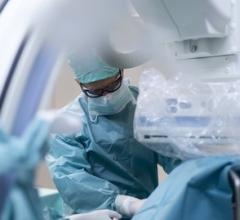The Pandemic’s Toll on Radiology

Signs for "Heroes work here" outside healthcare facilities and even the homes of clinicians have popped up across the country. This photo shows healthcare workers at the Lenox Health emergency room entrance being greeted to cheers and thanks for their essential service during the COVID-19 pandemic in New York City at a public thank you event May 21, 2020.
Radiology, like all the departments in hospitals and clinics, has undergone significant changes since early-2020, namely a large reduction in procedure volumes and in finding new ways to communicate with patients via telehealth.
Ajay J. Kirtane, M.D., Columbia University Irving Medical Center and NewYork-Presbyterian Hospital, stated what most clinicians in all of the ‘ologies who have been on the front line of the pandemic are feeling during a recent virtual meeting for the Society of Cardiovascular Angiography and Interventions (SCAI). “Until things hit close to home, we really had no idea what we were in for. None of us could really have predicted how this would happen or how we could ever prepare for it. When people see pictures and they say that isn’t real, I assure you it was definitely real and it was horrific,” Kirtane explained. “We were simply overrun. We did not have enough PPE, and there were hospitals where nurses were actually wearing garbage bags. These are true stories. There was rationing of PPE, there were not enough N95 or even surgical masks to go around. Our hospital was overrun by COVID cases, where almost 90 percent of our patient volume was COVID only, so we had no room to accommodate any other disease processes in the hospital had we continued to operate business as usual.”
The economic implications of this pandemic also continue to take a toll. In “The Economic Impact of the COVID-19 Pandemic on Radiology Practices” authored by Joseph J. Cavallo, published in Radiology, details the impact of COVID-19 on radiology. According to the article, “Radiology groups have never experienced an economic recession exacerbated by the simultaneous need to restrict the amount of imaging provided. This combination of events will severely stress the financial health of radiology groups throughout the country. Many practices will need to make short-term changes to survive this period and permanent changes to the radiology practice environment are likely in the long run.”
These potentially devastating effects could last for months — the authors of the article suggest a minimum of 3-4 months, during which radiology practices could see a volume decrease from 50-70 percent. The biggest service decrease was in screening radiology (mammography), which took a huge hit when all elective surgeries and procedures were put on hold, according to a new survey on imaging during the pandemic. Responses were tallied from around 170 radiology administrators and business managers, who are part of an imagePRO panel created by The MarkeTech Group (TMTG), regarding the effects of COVID-19 on their business. You can read more about this study’s results in the July/August issue, here.
And, in parting, I’d like to introduce our newest column, Parting Thoughts. In this column, industry expert Jef Williams from Paragon Consulting shares his thoughts on data engagement to help guide readers through this rapidly changing industry.



 December 05, 2025
December 05, 2025 









